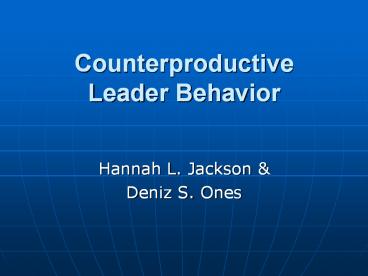Counterproductive Leader Behavior - PowerPoint PPT Presentation
1 / 26
Title:
Counterproductive Leader Behavior
Description:
CWB is intentional/volitional behavior enacted by employees and viewed by the ... Researchers have tended to treat leaders and their behaviors as essentially ... – PowerPoint PPT presentation
Number of Views:140
Avg rating:3.0/5.0
Title: Counterproductive Leader Behavior
1
Counterproductive Leader Behavior
- Hannah L. Jackson
- Deniz S. Ones
2
Counterproductive Leader Behavior
- Intentional behavior enacted by leaders that
involves misuse of position or authority for
personal and/or organizational benefit - Leader behavior may be acceptable by the
organizations standards but violate societal
norms
3
Counterproductive Workplace Behavior (CWB)
- CWB is intentional/volitional behavior enacted by
employees and viewed by the organization as
contrary to its legitimate interests
4
CWB and Leaders
- Researchers have tended to treat leaders and
their behaviors as essentially distinct from
those considered in existing CWB theories and
models
5
The Prevalence of CWB
- CWB has been recorded for workers of all types of
organizations and for employees at all levels
within them, whether they be salaried
professionals or nonprofessionals, managers or
non-supervisory employees
6
Why Examine Leaders and CWB?
- Opportunities for serious misconduct are at least
as great among managers and executives - A handful of leaders engaging in CWB can do as
much if not more damage than a large number of
front-line workers
7
Leaders and Ethics
- Ethical issues are ever present for leaders, who
must continually face conflicting stakeholders,
interests, and values
8
Transformational Leadership
- Communicating a collective vision and inspiring
their followers to look beyond self-interests and
perform for the good of the group
9
Transactional Leadership
- Controlling followers behaviors and handling
problems by engaging in some transaction between
the leader and subordinate
10
What Makes an Unethical Leader?
- Frequently operate with egotistic intent
- Employ controlling versus empowering strategies
to influence followers - Fail to abstain from vices
11
Taking a Broad View of CWB
- Allows researchers to generalize to unstudied but
related behavior - The possibility of a unified concept or dimension
of CWB - The possibility of finding common antecedents
12
One View of CWB
- CWB can be grouped into broad categories
- Property Deviance - acquisition or damage of
employer assets - Production Deviance - violation of norms
specifying the quality and quantity of work to be
accomplished - Interpersonal CWB Sexual harassment and verbal
abuse
13
A Recent Model of CWB
- CWB can be distinguished between behaviors
targeted at the organization and behaviors
targeted at organization members - Further divided by behaviors directly related to
job performance and behaviors not related to job
performance
14
What About Leaders?
- It seems likely that misconduct by leaders has
elements in common with misconduct by others - If leadership behavior is different, this
represents an opportunity to expand the CWB
construct
15
Antecedents of CWB
- Considering both personality and environmental
antecedents will be essential for a complete
understanding of CWB
16
Individual Difference as Antecedents
- Problems in socialization
- Attitudes regarding deviance and theft
- Problems with authority
- Excitement seeking
- Social influence
- Unstable upbringing
- Unmet needs
17
Situational Influences as Antecedents
- Inflexible policies
- Organizational injustice
- Competitive environment
- Economic conditions
- Reward systems
- Adverse working conditions
- Organizational culture
18
Environmental Factors
- Leaders have some control over the situational
factors that might influence CWB therefore it is
worth considering individual differences
19
Individual Differences, Leadership, and CWB
- Integrity tests substantially predict CWB
- The big five personality variables of
agreeableness, conscientiousness and emotional
stability are associated with CWB
20
Perpetrators Explanations for Their CWB
- Denial of harm
- Unnecessary or unjust laws
- Achievement vital to economic goals or even
survival - Expectations and pressure from others
- Everybody else is doing it
21
Guidelines for HR
- Train employees to reflect upon a proposed action
or decision from another perspective
22
Guidelines for HR Continued
- Consider some form of performance evaluation
approach to enable others to focus not only on
the numbers/financials produced by leaders, but
also how they were met
23
Guidelines for HR Continued
- Foster an ethical environment through
- Mechanisms for reporting and discussing perceived
ethical issues/problems without fear of
retribution - Verification procedures for code-compliance
during key activities
24
Guidelines for HR Continued
- Senior leaders should be encouraged to share
information publicly about important
organizational decisions - Senior officials should signal support for
ethical values
25
Reversing CWB
- External change agents are likely to be the most
successful because - They signal a break with the past and an
intention to change for the future - They bring with them a different perspective that
promotes questions about long held practices
26
Summary
- This chapter examined
- The construct of CWB
- Antecedents to CWB
- Leadership and CWB
- Environmental factors and CWB
- Guidelines to prevent CWB































